Introduction
The “Duplicate, Google chose different canonical” (DC) issue is one of the most complex challenges in international SEO. It often arises on multilingual and multi-regional websites where conflicting site-wide signals can influence Google to choose a different canonical URL than the one declared.
However, with experience working with over 150 airlines, we have consistently identified and successfully resolved the root causes.
This guide begins by explaining the “Duplicate, Google chose different canonical” issue and the factors influencing Google’s canonical selection. It then offers a brief, step-by-step, structured approach to diagnosing DC indexing problems, helping you pinpoint the root cause of this complex issue by leveraging tools such as Google Search Console, Screaming Frog, and more.
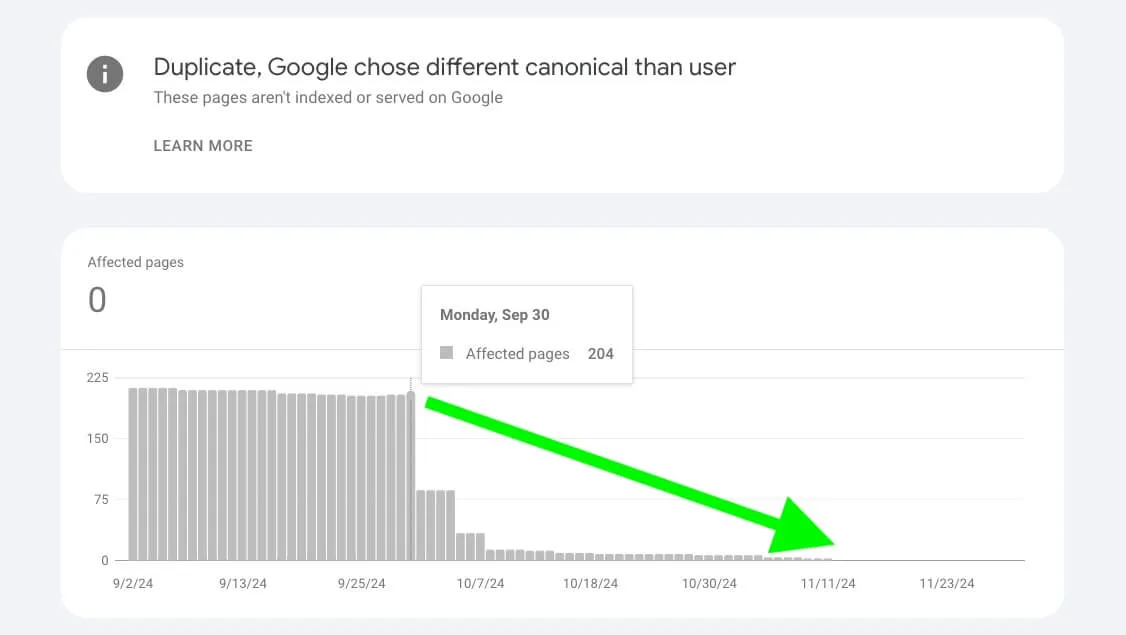
What does “Duplicate, Google chose different canonical” actually mean?
In the image below, we tested the Canadian version of the URL /en-ca/cheap-flights, which contains a self-referential canonical. However, Google happens to have selected the /en/cheap-flights URL as the preferred canonical. Why Google?
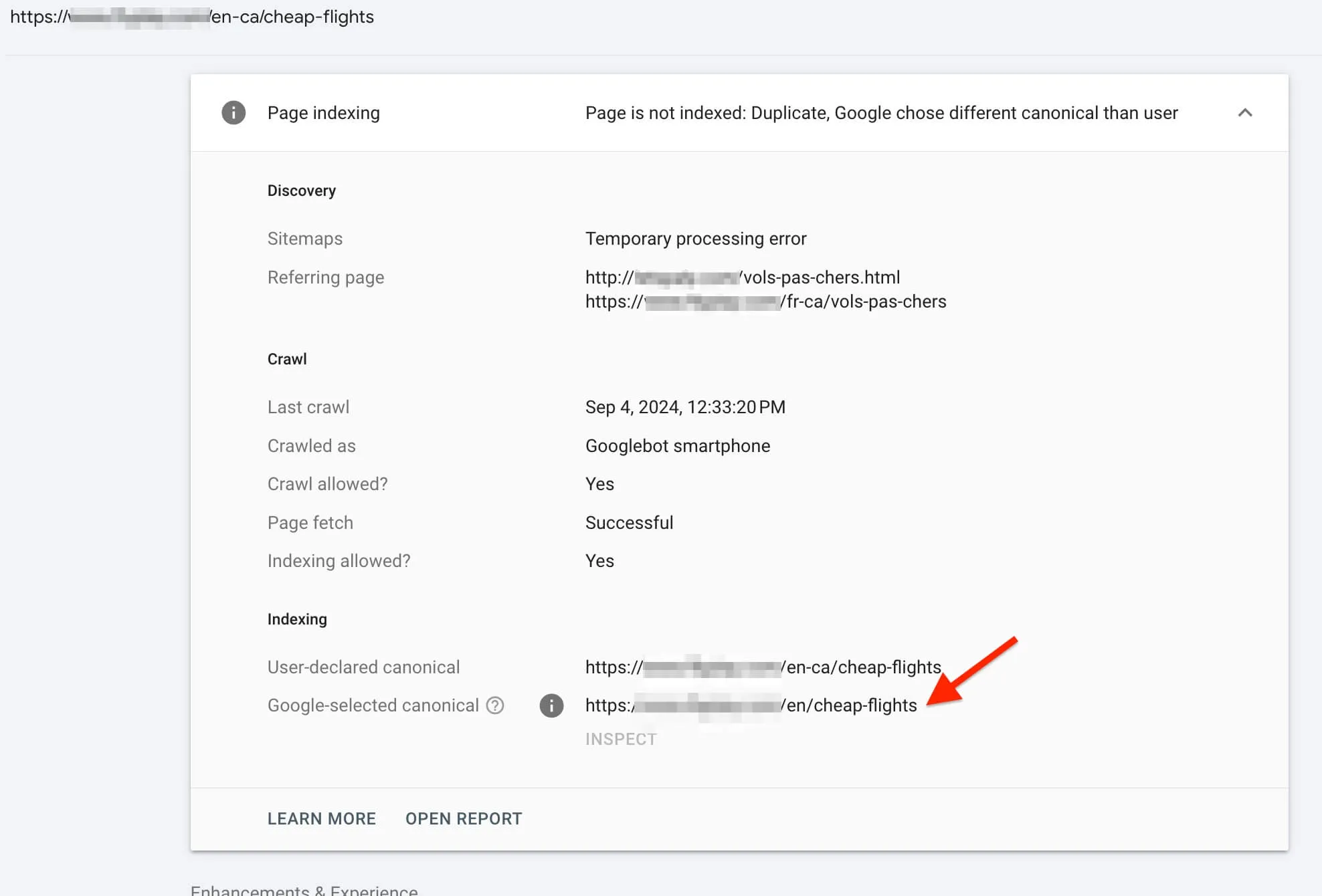
Google’s documentation indicates that:
“Google thinks that the tested page isn’t a duplicate of the user-declared canonical. Instead, Google believes that the tested page is a duplicate of the Google-selected canonical.
- If the Google-selected canonical is the tested page, then Google thinks that the tested page isn’t similar to any other page.
- If the user-declared canonical is not identical to the current page, then Google won’t ever choose that URL as canonical. A duplicate page must be similar to the canonical. (That’s what duplicate means.)”
Now, let’s look at how Google chooses a canonical.
How Does Google Choose a Canonical?
Google’s documentation suggests that many factors influence canonicalization, including:
- page is served over HTTP or HTTPS,
- redirects,
- internal linking,
- presence of the URL in a sitemap,
- rel=”canonical” link annotations.
- “Nicer” – looking URLs.
However, in one episode of the Search Off the Record podcast, a Google advocate indicated that there are approximately 40 distinct signals that Google uses to determine which page to serve as the canonical page.
In a similar note, Google’s spokesperson, John Muller, referred to these factors or hints in one of Search Central’s videos as the site’s preference signals. These cues or signals tell Google which URLs the site wants Google to index. Therefore, Google encourages sites to use these preference signals consistently.
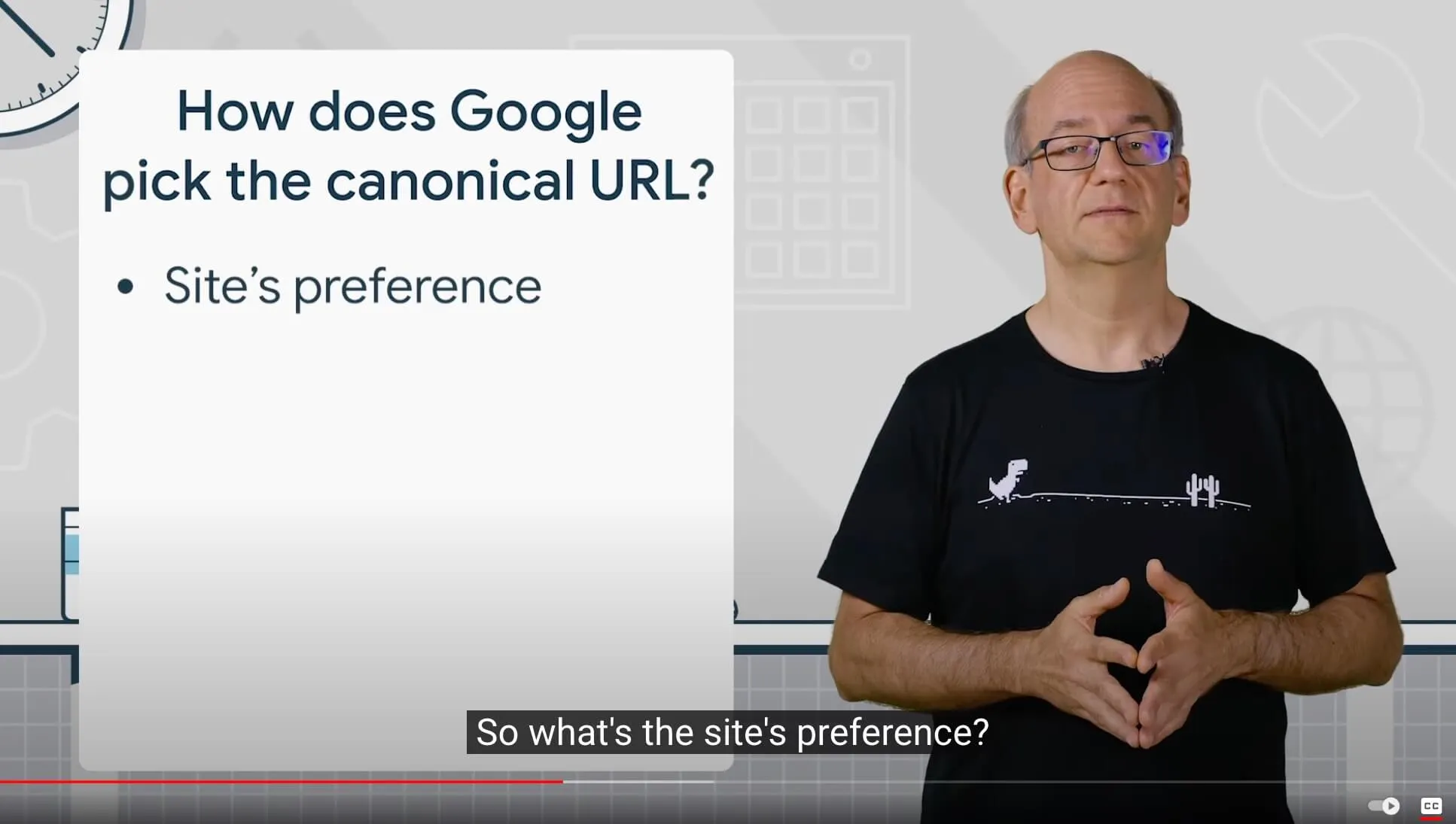
The key takeaway is that you can indicate your preference to Google using these techniques, but Google may sometimes choose a different page as canonical than you do.
Therefore, even though all airTRFX pages use a self-referring canonical tag, Google may consider it a hint, rather than a rule, that is, when the broader site’s signals indicate to Google that there is an underlying preferred site edition or page.
Most recently, Google has indicated that the “Duplicate, Google chose different canonical than user” status is not inherently harmful, suggesting that the content and the pages can still be indexed.
During an SEO Office Hours session in July 2025, Google’s advocate Martin Splitt clarified that URLs flagged this way can still be indexed as part of a language or near-duplicate cluster, yet won’t likely show as indexed or receiving traffic on GSC’s performance and indexing reports. The canonical shown in GSC reflects Google’s preferred page, not necessarily the version displayed in the local SERPs.
We validated this with the help of GA4. Here is a brief example of the /flights-to-houston page.
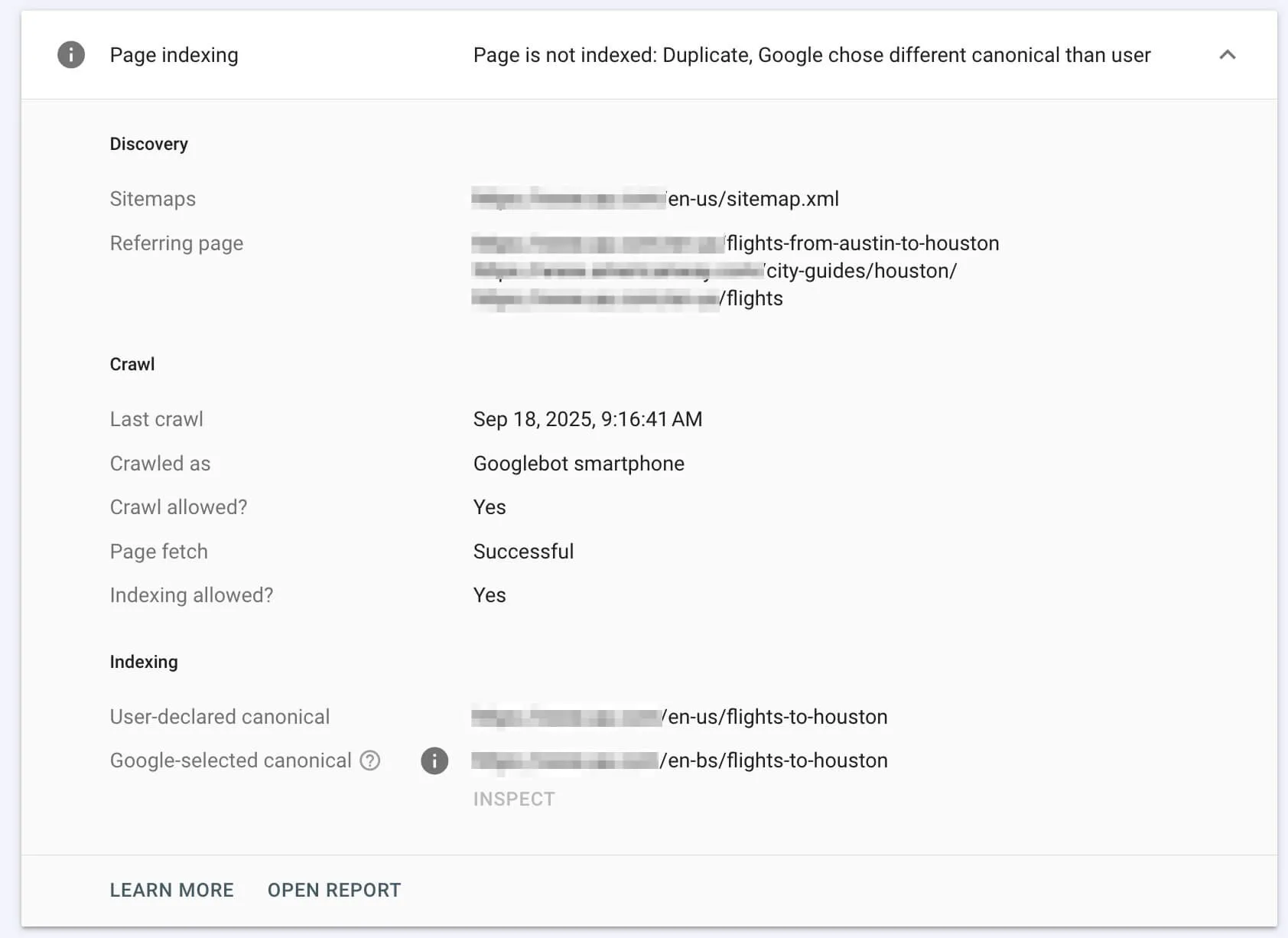
Notice how the /en-us/flights-to-houston page which was flagged in the DC report on GSC shows nearly zero clicks in the performance report.
It seems as if the URL is de-indexed for many months.
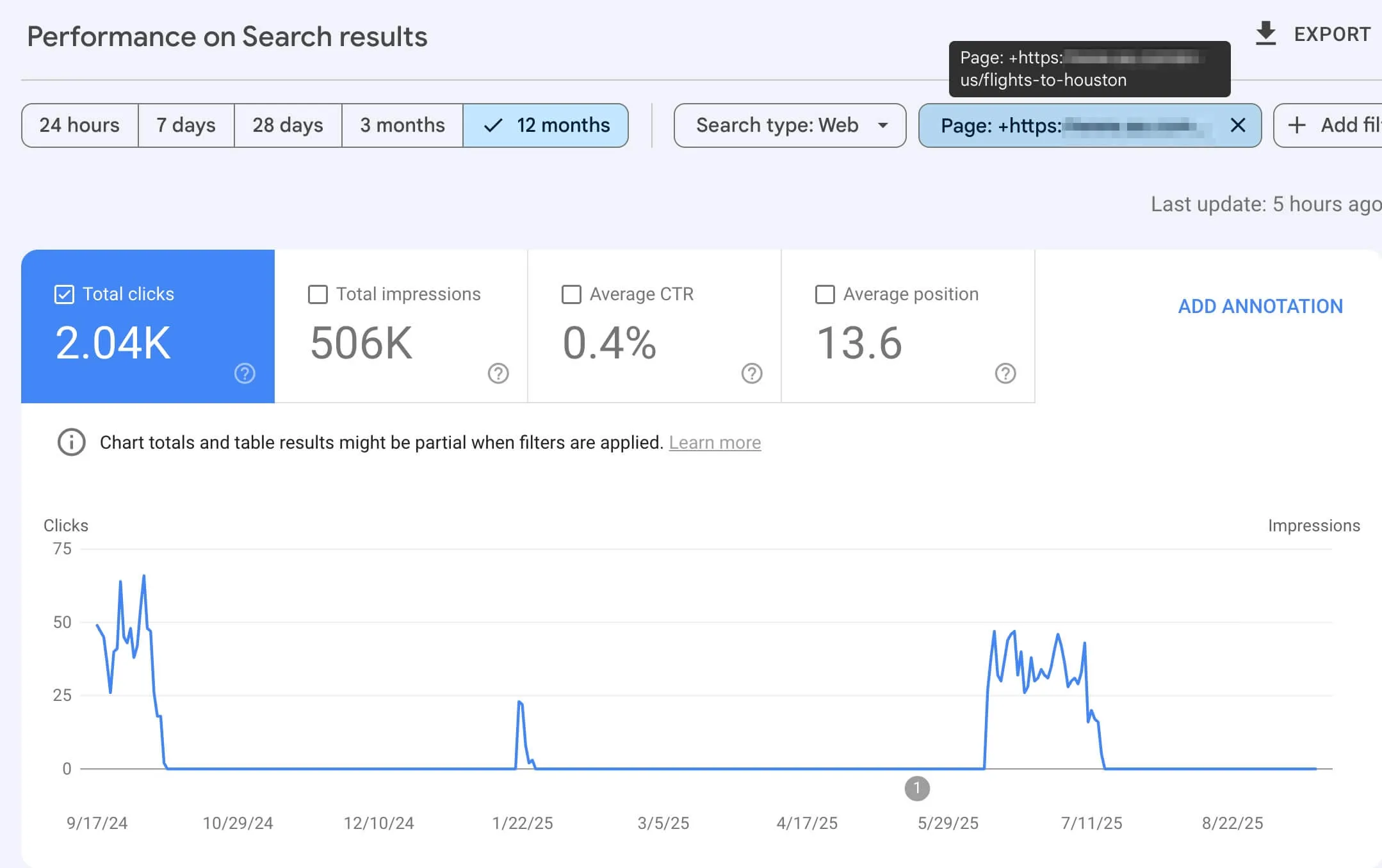
However, the same URL recorded steady Organic traffic on GA4, which means that the URL was always indexed.
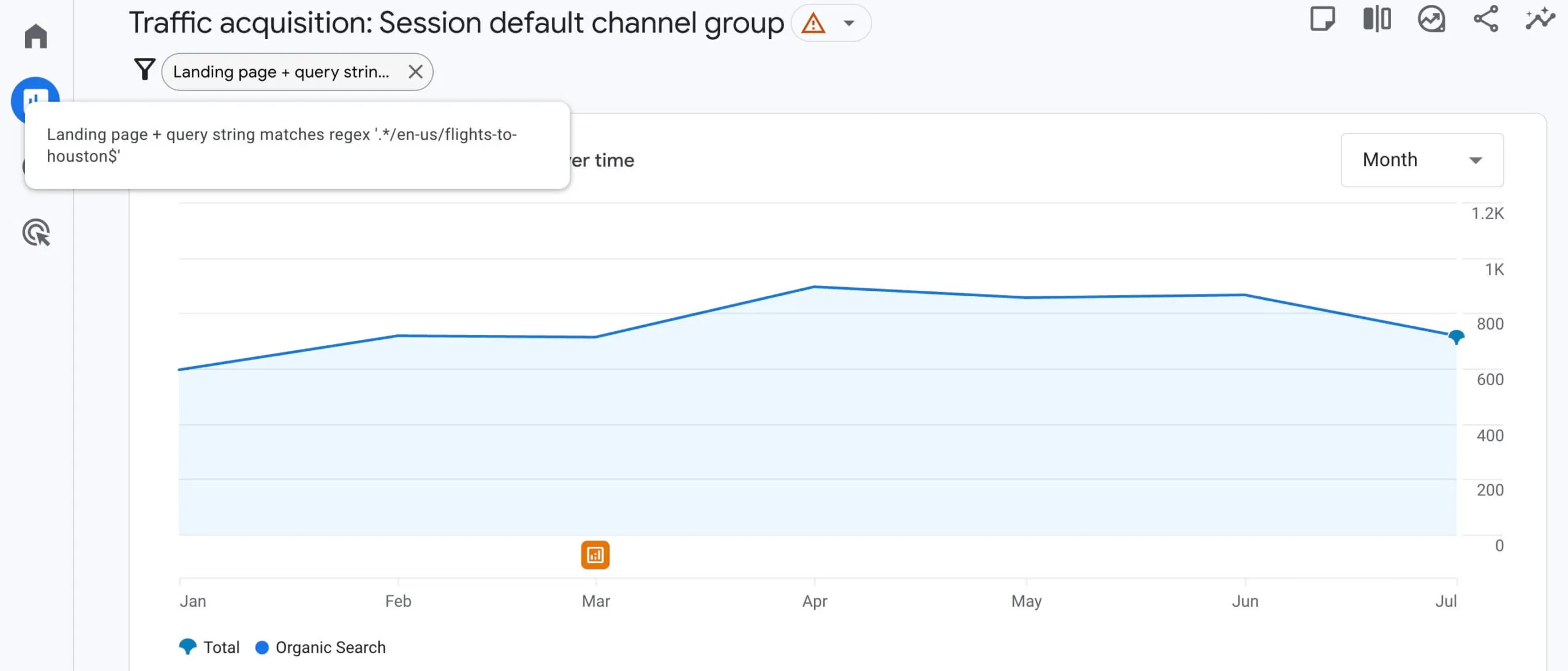
You can validate this for all the URLs flagged on GSC. Most of the time that DC appears, we have confirmed that over 90% of URLs continue receiving traffic and are ranking in the SERPs.
What is the root cause of this issue?
From experience with many airlines’ multi-regional sites, 95% of the time, the root cause of this issue is attributed to underlying misaligned internal links and redirects.
💡Insight → The header and footer menus are the most common culprits of conflicting internal links.
Most times, links are pointing to site editions of the same language but to an unintended localized version (e.g., a good number of links in the header menus of /en-us/, /en-ca/, and /en-gb/ site editions contain links pointing to the /en/ site edition or vice versa).
Some other common places where we have found misaligned internal links are:
- New blocks of internal links
- New blocks of content, including links to other unintended site editions
- New carousel modules
- Non-200 links in the Hreflang annotations
- Custom pages with links to different country-market site editions
As noted in the previous question, Google evaluates the site’s preference signals holistically when determining a canonical, analyzing signals at the site edition level rather than individual pages.
Therefore, if the core website experiences misaligned site preference signals and shares a subfolder with airTRFX, the “Duplicate, Google chose different canonical” issue can indirectly affect airTRFX, too. In such cases, Google may select a significant portion of pages—or even an entire site edition—as the canonical for another site edition.

To confirm the above, 🤖 Google said here:
“It usually happens if internal links are pointing to another URL instead of what the canonical declares. To fix it, look for internal links pointing at this URL and change them so they point to your desired canonical URL instead. Should these links come from other websites, you can configure your server to redirect to the canonical URL by using 301 redirects.”
We now know the root cause and that “Duplicate, Google chose different canonical” (DC) does not represent a true indexing problem. Still, it can trigger secondary issues when Google favors one page over another.
Although the non-canonical page remains indexed, potential user experience problems emerge if it qualifies for a Product rich snippet. In these cases, the SERP may display a “Starting from $$” value taken from the page that Google selected as canonical instead. This can surface the wrong fare or currency, creating a misleading experience for users.
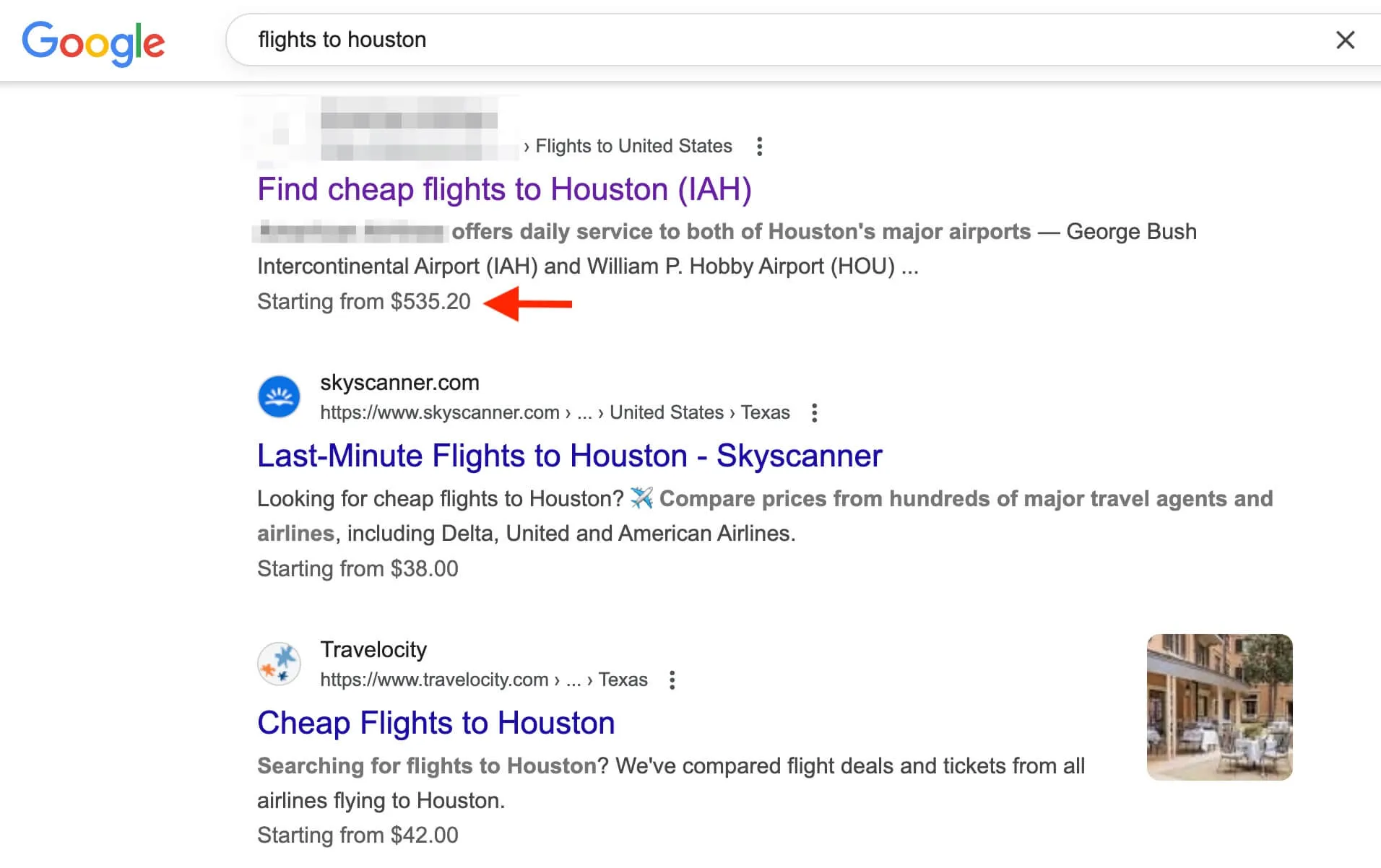
These mismatches happen because of how Google interprets canonical signals across the site, not because airTRFX shows the wrong fares. airTRFX pages are correctly set up and align with Google’s canonicalization best practices, but airlines should still monitor SERPs for anomalies and adjust internal links or redirects if needed to keep prices accurate. The next section will guide you through fixing misaligned internal links to reduce this risk.
How do you troubleshoot misaligned internal links?
Troubleshooting DC requires a deep investigation and advanced knowledge of tools such as Screaming Frog, the Google Search Console Links Report, and the Wayback Machine.
Below, you will find a brief list of steps to investigate and find the root cause of this issue. When assessing internal links, consider the following three scenarios.
These are:
- Links from the airline’s core website —> airTRFX
- Links from airTRFX —> airTRFX
- Links from airTRFX header/footer menus —> airline’s core website
- Links from External Sites —> airTRFX
1. Start by laying the ground (the basics):
- Validate that all the canonical tags on the core site are self-referring and correct.
- Recommended to crawl the whole site with Screaming Frog and review the Canonicals Report.
- This is likely not an issue on airTRFX pages as the system launches pages properly canonicalized.
- Understand the Site’s Structure:
- Assess the regional, linguistic, and structural setup of both the core website and airTRFX.
- Identify whether subfolders or URL patterns are shared between the core site and airTRFX.
- Identify Key Dates:
- Use Google Search Console (GSC) to pinpoint spikes or trends in the “Duplicate, Google chose different canonical” issue.
- Focus on site editions or languages most affected during those periods.
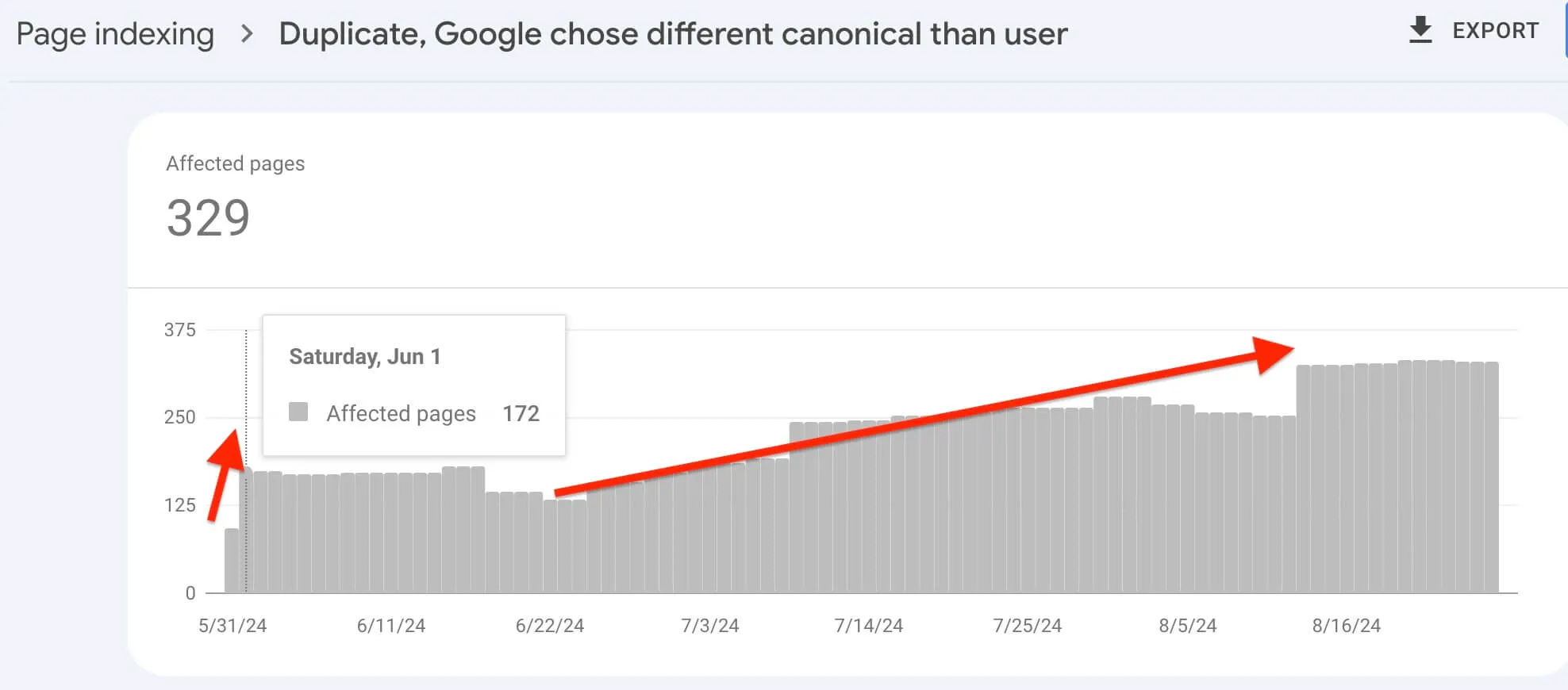
- Gather Recent Changes:
- Investigate if there were recent updates 1-3 months prior to the issue spike on Search Console. Consider potential changes, such as new header/footer sections with links, new interlinking blocks, new site editions, and new content blocks.
- Validate whether performance is impacted. The nature in which GSC reports data (canonical data only) will suggest traffic loss or de-indexing issue; however, evidence that your page is still indexed and receiving traffic can be done through:
- GA4 Traffic Stability: Most flagged URLs continued to receive organic sessions in GA4 after the reported spike on GSC.
- Ranking Stability: AWR tracking showed consistent rankings for localized URLs (e.g., /ll-mm/) targeting their intended markets.
- SERP Presence: Manual checks using VPN connections in affected markets confirmed that the pages remained visible and ranking.
2. Start Digging: Find Misaligned Links and Redirects
- Audit Internal Links:
- Inspect header and footer menus, breadcrumbs, interlinking modules, and anchor links for inconsistencies.
- Use the GSC’s Links report to identify misaligned internal links between languages or market site editions in the same language
- Get familiar with the Links report. Please note that the report is limited to a sample of pages from your site, and some URLs may be omitted due to various reasons, such as non-indexed URLs, deduplicated clusters, and other factors.
- You may need to export to a spreadsheet and filter out the URLs that are appropriately linked or aligned with the corresponding site edition.
- Validate consistency on 301 Redirects in the past:
- Work with your webmaster or SEO team to crawl old destination URLs and check if redirects match the intended page template and site editions correctly.
- Identify erroneous redirects or redirects leading to broken pages.
3. Dig Deeper: Advanced Analysis
- Wayback Machine:
- Compare historical versions of affected pages to identify changes in interlinking, page structure, or content that could impact the site’s preference signals.
- Leverage Screaming Frog to identify issues at scale
- Download the Screaming Frog’s All Inlinks report to identify misaligned internal links between languages or market site editions in the same language.
- Ensure hreflang annotations are properly implemented, with no missing return links, non-200 URLs, or conflicting tags.
- Verify that canonical tags are consistent and self-referential site-wide.
4. Implement Fixes:
- Following the findings and insights from the previous step, you will want to work with your IT team or webmaster and ensure internal links are aligned site-wide.
- Align internal links across site editions to match canonical preferences.
- Update redirects to resolve mismatches and ensure proper alignment between page templates and site editions.
- Fix hreflang and canonical issues to ensure consistent signals for multilingual or multi-regional pages.
5. Monitor and Validate Fixes:
- In a matter of 2-3 weeks, you should see a decaying trend of errors in the Coverage Report for Duplicate, Google Chose a Different Canonical.
- Document your fixes and align internally with your webmaster or the airTRFX lead for reference in future updates on your core website or airTRFX pages.
- Validate Performance and Indexing Stability
- Traffic: In GA4, compare organic sessions for flagged URLs before and after the spike.
- Rankings and Visibility: In AWR (or your preferred keyword-tracking tool), track rankings for target URLs in the affected site edition.
- SERP Spot Checks: In SERPs, leverage a VPN-based check in the target country for relevant queries.
Why Does It Still Matter
Even when visibility and traffic remain stable, there is a potential impact on user experience if two pages appear on the SERP and the user encounters a page displaying prices or currencies from another market in the same language. Therefore, addressing the root cause of misaligned site preference signals, which in most cases comes down to misaligned internal links, remains a relevant approach.
Summary and Key Considerations
In summary, the DC issue is a common challenge for multi-lingual and multi-regional websites, often caused by conflicting site-wide signals that influence Google’s canonical selection.
Google evaluates these signals holistically at the site level, not page by page, which means misaligned links and redirects across site editions or between the core website and airTRFX can lead to this issue.
Additionally, when the core site shares a subfolder with airTRFX, the misalignment of site preference signals on the core site may cause Google to select an entire site edition as the canonical for another, thereby impacting airTRFX pages as well. This highlights the importance of maintaining consistency across internal links and redirects between airTRFX site editions and page templates, as well as between the airline’s core website and corresponding airTRFX languages or country-market editions.
Some key considerations to prevent misaligned signals are:
- Maintain consistency between airTRFX and the core website by keeping interlinking up to date. This also applies when adding new airTRFX site editions or languages to your site.
- Validate redirects to ensure they align with the intended page templates and site editions.
- Ensure consistency in canonical and hreflang tags across all site editions on the core site.
- Audit internal links across the core site and airTRFX, ensuring they point to the correct canonical URLs.
- Be mindful of changes both on airTRFX and the core site, such as updating links or creating new blocks of internal links, which may require adjustments to the canonical structure.
- Monitor performance via GA4, AWR, and GSC, and track improvements after implementing fixes.
By maintaining consistency across these key areas, you can significantly reduce canonicalization conflicts and improve how Google indexes your pages.
Finally, if you find that airTRFX is likely affected by this issue, validate that your pages are still indexed with the help of other analytics tools and SERP. Treat most instances of this status as a reporting shift on Search Console, unless visibility, traffic, or conversions clearly decline.
More Resources
- What is URL canonicalization – Google Search Central
- Video – How to avoid Duplicate Content – Google Search Central
- Reasons to specify a canonical URL and best practices – Google Search Central
- Video – Canonical URLs: How Does Google Pick the One? – Google Search Central
- Managing multi-regional and multilingual sites – Google Search Central
- Links Report – Google
- Google Chooses Canonical: Avoid Duplicate Pages & Win at SEO – Slaterock Automation
Frequently Asked Questions
The pages may or may not be actually indexed. We encourage you see beyond GSC and monitor the flagged pages via GA4 or your preferred keyword tracking and analytics tools. Additionally, run spot checks of what appears in local SERPs. Your pages may still be receiving traffic.
In most airTRFX cases, no. Data shows flagged pages continue receiving sessions and rankings. The risk is more about user experience if the wrong market version surfaces.
Google weighs many site wide signals, including internal links, redirects, and hreflang. If these are inconsistent, Google may override your declared canonical.
Audit and align internal links (especially header/footer), validate redirects, check hreflang and canonical consistency, and re-submit fixes in GSC. Monitor improvements with GA4, AWR, and run SERP spot checks with the help of a VPN.
Treat it first as a reporting quirk. Validate with GA4 and ranking tools before assuming an indexing or traffic loss. Act only if visibility or conversions clearly decline.

